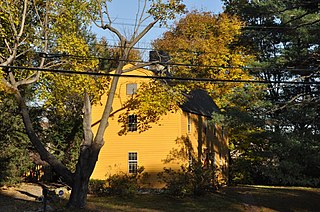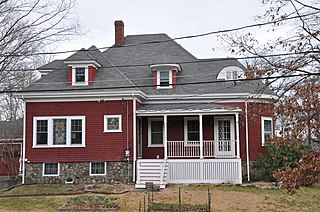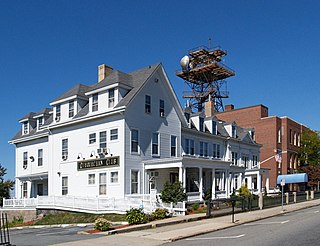Sgt. William H. Carney House | |
 Sgt. William H. Carney House | |
| Location | New Bedford, Massachusetts |
|---|---|
| Coordinates | 41°38′15″N70°55′59″W / 41.63750°N 70.93306°W |
| Built | 1850 |
| NRHP reference No. | 75000243 [1] |
| Added to NRHP | April 21, 1975 |
Sgt. William H. Carney House | |
 Sgt. William H. Carney House | |
| Location | New Bedford, Massachusetts |
|---|---|
| Coordinates | 41°38′15″N70°55′59″W / 41.63750°N 70.93306°W |
| Built | 1850 |
| NRHP reference No. | 75000243 [1] |
| Added to NRHP | April 21, 1975 |
The Sgt. William H. Carney House is a historic house at 128 Mill Street in New Bedford, Massachusetts. The house was built in 1856, and is a 2+1⁄2-story wood-frame structure with Greek Revival styling. It has a three-bay front facade, with the entrance in the left bay, sheltered by a hip-roofed bracketed hood. It is notable as the home of William Harvey Carney, an enlistee in the African-American 54th Massachusetts Volunteer Infantry. Carney distinguished himself at the Battle of Fort Wagner, actions for which he was belatedly awarded the Medal of Honor. [2]
The house was listed on the National Register of Historic Places in 1975. [1]

William Harvey Carney was an American soldier during the American Civil War. Born enslaved, he was awarded the Medal of Honor in 1900 for his gallantry in saving the regimental colors during the Battle of Fort Wagner in 1863. The action for which he received the Medal of Honor preceded that of any other African American Medal of Honor recipient; however, his medal was actually one of the last to be awarded for Civil War service. Some African Americans received the Medal of Honor as early as April 1865.

New Bedford Whaling National Historical Park is a United States National Historical Park in New Bedford, Massachusetts, and is maintained by the National Park Service (NPS). The park commemorates the heritage of the world's preeminent whaling port during the nineteenth century.

Effie M. Morrissey is a schooner skippered by Robert Bartlett that made many scientific expeditions to the Arctic, sponsored by American museums, the Explorers Club and the National Geographic Society. She also helped survey the Arctic for the United States Government during World War II. She is currently designated by the United States Department of the Interior as a National Historic Landmark as part of the New Bedford Whaling National Historical Park. She is the State Ship of Massachusetts.

The Nathan and Mary (Polly) Johnson properties are a National Historic Landmark at 17–19 and 21 Seventh Street in New Bedford, Massachusetts. Originally the building consisted of two structures, one dating to the 1820s and an 1857 house joined with the older one shortly after construction. They have since been restored and now house the New Bedford Historical Society. The two properties are significant for their association with leading members of the abolitionist movement in Massachusetts, and as the only surviving residence in New Bedford of Frederick Douglass. Nathan and Polly Johnson were free African-Americans who are known to have sheltered escaped slaves using the Underground Railroad from 1822 on. Both were also successful in local business; Nathan as a caterer and Polly as a confectioner.

The William Rotch Jr. House, now the Rotch–Jones–Duff House and Garden Museum, is a National Historic Landmark at 396 County Street in New Bedford, Massachusetts, in the United States. The three families whose names are attached to it were all closely tied to the city's nineteenth-century dominance of the whaling industry. Because of this, the house is part of the New Bedford Whaling National Historical Park.

The William J. Rotch Gothic Cottage is a historic cottage on 19 Irving Street in New Bedford, Massachusetts. The Gothic Revival cottage was built in 1845 to a design by noted New York City architect Alexander Jackson Davis. It was built for William J. Rotch, a member of one of New Bedford's leading whaling families. It is for these two associations that it was designated a National Historic Landmark in 2006. It is one a very few surviving Gothic cottage designs by Davis, exhibiting features not found in the others that do. The house was included in The Architecture of Country Houses, published in 1850, bringing it early fame and making it an iconic example of the style.

The Sgt. Harlow William Family Homestead is a historic house at 8 Winter Street in Plymouth, Massachusetts. The oldest portion of this 1+1⁄2-story gambrel-roofed Cape house is believed to have been built by Sergeant William Harlow, before he built the nearby Old Harlow Fort House, and is believed to be one of Plymouth's oldest surviving buildings. It is unclear from the architectural evidence whether the original structure was a single cell or full width ; the asymmetry of the front facade suggests it was built in stages. The house has a large addition, which was added to the rear in the 19th century.

The New Bedford Fire Museum is a local history museum at 51 Bedford Street in New Bedford, Massachusetts, United States. It is located in the 1867 Fire Station No. 4, the city's oldest surviving fire station. The building was listed on the National Register of Historic Places in 1975. The museum is open between July 4 and Labor Day. It houses a collection of firefighting equipment and memorabilia related to the history of firefighting in the city.

Bedford Depot is a historic railroad depot in Bedford, Massachusetts, United States. Bedford was the junction of the Reformatory Branch and the Lexington Branch of the Boston and Maine Railroad; it saw passenger service until 1977 as the stub of the Lexington Branch. The original 1874 depot and 1877 freight house are listed on the National Register of Historic Places; along with a restored Budd Rail Diesel Car, they form the centerpieces of the Bedford Depot Park.

The Nathaniel Page House is a historic colonial First Period house in Bedford, Massachusetts. It was originally thought to date from 1687, but an investigation conducted by the "This Old House" television program placed the actual date of construction at about 1720. The house is a 2+1⁄2-story wood-frame structure, five bays wide, with a side-gable roof, clapboard siding, and a central chimney. A single-story ell extends to the left side of the main block.
List of Registered Historic Places in New Bedford, Massachusetts.

The Capt. William Green House is a historic colonial house at 391 Vernon Street in Wakefield, Massachusetts. It is one of Wakefield's oldest surviving buildings. The house was listed on the National Register of Historic Places as part of two separate listings. In 1989 it was listed under the name "Capt. William Green House", and in 1990 it was listed under the name "Green House".

The House at 2 Nichols Street in Wakefield, Massachusetts, is a well-preserved, architecturally eclectic house built in the 1890s. The 1+1⁄2-story frame house has elements of the Tudor Revival, Queen Anne, and Shingle styles, and is one of two identical houses built by local builder Berndt Heurlin. It has a hip roof, but transverse gables, one of which has a rounded bay, giving it a Queen Anne feel. The foundation exterior is fieldstone, and there are several stained glass windows.

The United States Customhouse is a historic and active custom house at 2nd and William Streets in New Bedford, Massachusetts. Architect Robert Mills designed the custom house in 1834 in a Greek Revival style. It has been used by the U.S. Customs Service ever since, and today serves as a port of entry.
New Bedford Public Schools (NBPS) is a school district serving New Bedford, Massachusetts, United States. Its headquarters are in the Paul Rodrigues Administration Building.

Nathaniel Cannon Smith (1866–1943), professionally known as Nat. C. Smith, was an American painter and architect of New Bedford, Massachusetts.

Hazelwood Park is a public park on Clark's Point in New Bedford, Massachusetts. The park occupies a plot of 23 acres (9.3 ha) on the west side of New Bedford's southern peninsula, between Rodney French Boulevard and Brock Avenue. It overlooks Clark's Cove which opens into Buzzards Bay. The park was listed on the National Register of Historic Places in 2010.

The Manomet Mills are a historic textile mill complex on the north side of New Bedford, Massachusetts. They are located between Riverside Avenue and the Acushnet River, north of Manoment Street and the Whitman Mills. The complex consists of three Classical Revival brick buildings, built between 1903 and 1907. The main building, Mill No. 1, is a 54-bay three story structure that was built in 1903. It is attached to Mill No. 2 (1907), of similar size, by a single story brick structure. The third building is the Mill No. 2 Department Room (1907), a two-story brick building that was originally connected to the other two via overhead bridges, now removed. The mill complex was the main operating site of the Manoment Mill Company, which produced cotton yarn until about 1928. The buildings were sold in that year to the Delaware Rayon Company, which went bankrupt in 1954. Mill No. 2 was then used by the Acushnet Process Company for the manufacture of golf balls, while Mill No. 1 continued to be used for rayon production, a chemically intensive and environmentally hazardous process.

The Oak Grove Cemetery is a historic cemetery on Parker Street in New Bedford, Massachusetts. It consists of two parcels, separated by Parker Street, northwest of the city's central business district. The older portion of the cemetery, that south of Parker Street, was established in 1843, while the northern section was acquired and developed between 1870 and 1896. Most of the cemetery is laid out in the then-fashionable rural cemetery style of winding lanes, although the northernmost section has a more open layout, made partly due to complaints about the cluttered nature of the rural cemetery style.
Page House may refer to: